Charts and code from NFPA help installers and facilities managers determine the distance required between fire sprinkler heads and objects
How much distance do fire sprinkler heads need from obstructions, whether permanent or temporary? It’s a concern with big impacts for every sprinklered building. Failing to place the proper distance between sprinklers and obstructions can stop the fire sprinkler from discharging on time—or will prevent sprinklers’ spray from reaching a fire or wetting materials that will burn.
In part two of our series on distances for fire sprinklers, we look at some of these sprinkler head obstruction distance rules for standard spray sprinklers—a common sprinkler type that uses different rates of discharge to defend against a wide range of hazards. We provide an overview of what the NFPA requires for obstructions—both permanent and temporary—and take a closer look at some fundamental rules on the subject:
- What is an obstruction and where are the rules regarding it found?
- Which obstruction rules apply to standard spray pendent, upright, and sidewall sprinkler heads?
- Which rules apply specifically to standard spray pendent and upright heads?
- Which rules apply specifically to standard spray sidewall heads?
This blog does not cover distances between sprinklers and walls (or between sprinklers)—for those, read Maximum and Minimum Sprinkler Distance Rules, Part 1: Standard Spray Fire Sprinklers.
If you’re in the process of installing or replacing sprinklers, we invite you to look at our selection of commercial fire sprinklers, including standard spray models, from industry-leading manufacturers like Senju, Victaulic, Tyco, and Reliable (RASCO).
Fire sprinkler head obstructions are covered in NFPA 13 and NFPA 25
What is an obstruction? NFPA 13: Standard for the Installation of Sprinkler Systems defines two types:
From the 2019 edition of NFPA 13
3.3.133 Obstruction.
3.3.133.1 Continuous Obstruction. An obstruction located at or below the level of sprinkler deflectors that affects the discharge pattern of two or more adjacent sprinklers.
3.3.133.2 Noncontinuous Obstruction. An obstruction at or below the level of the sprinkler deflector that affects the discharge pattern of a single sprinkler.
The NFPA 13 Handbook notes that these terms emerged to help installers better understand the NFPA’s intent regarding the placement and spacing of sprinklers. These definitions make it clear that it’s the impact on sprinklers, and not the design of the obstruction itself, that matters.
NFPA 13 deals largely with permanent obstructions—construction features that threaten to disrupt sprinklers’ spray patterns. But for those tasked with the ongoing care of fire sprinkler systems, there’s the matter of distances from temporary obstructions. We’ve taken a look at these in our multi-part series on what facility managers need to inspect on a fire sprinkler system.
In a nutshell, NFPA 25: Standard for the Inspection, Testing, and Maintenance of Water-Based Fire Protection Systems says that objects that can block a sprinkler’s spray must be at least 18 inches away from the deflector. (That’s the small metal part at the sprinkler’s forward edge.) There is an exception, however: In-rack sprinklers that are specifically designed for storage racks don’t observe this minimum requirement.
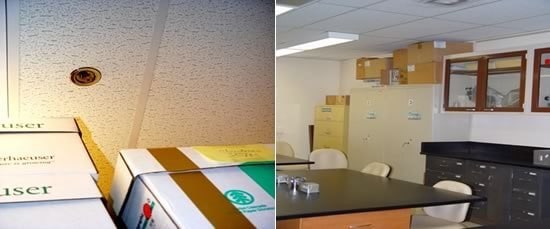
And in a few cases, 18 inches from obstructions isn’t enough. Sprinklers designed for specific hazards or features (special sprinklers) require three feet of clearance, as do those covering stored rubber tires. Further, state and local fire codes may override these sprinkler head obstruction distance rules and require greater clearance between sprinkler heads and storage.
All standard spray fire sprinklers must reduce risks from a variety of objects
While NFPA 13 addresses the subject of obstructions largely by sprinkler type, all standard spray sprinklers share a few common provisions presented in chapter nine.
Sprinklers must minimize obstructions to discharge in accordance with 9.5.5.2 and 9.5.5.3 or additional sprinklers must be added to provide adequate coverage (section 9.5.5.1). Further, if an obstruction is no more than 18 inches under deflectors—and if it prevents the sprinkler’s pattern from developing—nearby sprinklers must follow the minimum distance guidelines in chapter 10 (9.5.5.2)
If the obstruction is more than 18 inches below the deflector—and interrupts that discharge in a horizontal plane—it must comply with the guidelines of section 9.5.5.3, which addresses:
- Sprinklers under obstructions. Obstructions over four feet wide, including open-grate flooring, require sprinklers underneath (9.5.5.3.1 and 9.5.5.3.1.1). However, grate sprinklers must be protected against discharge from other sprinklers (9.5.5.3.4). Sprinklers below an obstruction must have their deflectors placed directly under it or within 3 inches (horizontally) of the obstruction’s outside edge, and may be anywhere from 1 to 12 inches below it (9.5.5.3.1.2 and 9.5.5.3.1.4).
- Noncombustible material. If the obstruction won’t burn, and its base is no more than two feet above the floor, sprinklers aren’t needed underneath (9.5.5.3.1.5).
- Temporary obstructions. Section 9.5.5.3.2 states that large conference tables and other objects that aren’t fixed in place don’t need sprinklers beneath them.
- One sprinkler at the highest ceiling level may serve a closet or compartment at or under 400 cubic feet in size—regardless of obstructions (9.5.5.4)
- Sprinkler types. Excluding overhead doors—which may have standard spray sprinklers underneath them—sprinklers below obstructions must be of the same type as those installed at the ceiling (9.5.5.3.3 and 9.5.5.3.3.1).
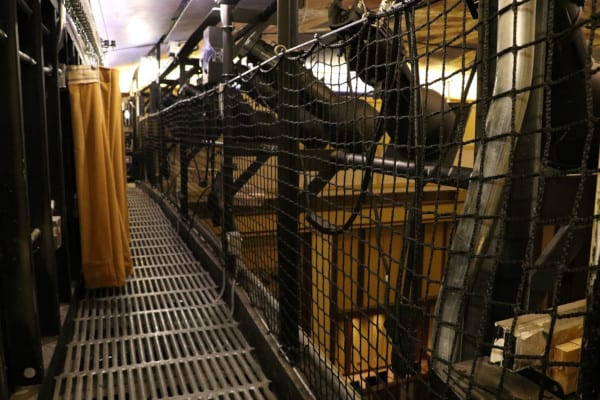
NFPA charts prescribe distances from obstructions to pendent or upright sprinklers
Each sprinkler must be positioned to minimize obstructions that prevent it from activating on time. Section 10.2.1.2 of NFPA 13 provides a few ways for pendent and upright sprinklers to comply with this requirement:
- Place the sprinkler in accordance with table 10.2.7.1.2 (shown below).
- For obstructions under four feet wide, installers may place sprinklers on opposite sides of the obstruction (so long as the distance between each sprinkler and the obstruction’s centerline doesn’t exceed half the distance allowed between sprinklers—see part 1 in this series).
- If a soffit or similar obstruction against a wall is no more than 30 inches wide, the sprinkler’s deflector may be positioned in compliance with Table 10.2.7.1.2. If it’s less than 24 inches wide, the deflector may be as high above the bottom of the obstruction as the installer wants—provided that it remains sufficiently close to the wall (again, see our previous blog to determine that distance).
Most of these rules refer to table 10.2.7.1.2. This table determines an appropriate distance between the sprinkler’s deflector and the bottom of an obstruction. As the distance from the fire sprinkler head to the obstruction’s side increases, so does the permissible vertical distance. Note also that the distance between the deflector and the side of the obstruction is measured from the deflector’s center.
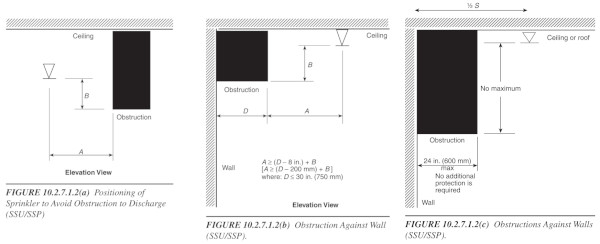
From the 2019 edition of NFPA 13
| TABLE 10.2.7.1.2 Positioning of Sprinklers to Avoid Obstructions to Discharge [Standard Spray Upright/Standard Spray Pendent (SSU/SSP)] | |||||||||||
| Distance from Sprinklers to Side of Obstruction (A) | Maximum Allowable Distance of Deflector Above Bottom of Obstruction (B) [in. (mm)] | ||||||||||
| Less than 1 ft (300 mm) | 0 (0) | ||||||||||
| 1 ft (300 mm) to less than 1 ft 6 in. (450 mm) | 2 1/2 (65) | ||||||||||
| 1 ft 6 in. (450 mm) to less than 2 ft (600 mm) | 3 1/2 (90) | ||||||||||
| 2 ft (600 mm) to less than 2 ft 6 in. (750 mm) | 5 1/2 (140) | ||||||||||
| 2 ft 6 (750 mm) in. to less than 3 ft (900 mm) | 7 1/2 (190) | ||||||||||
| 3 ft (900 mm) to less than 3 ft 6 in. (1.1 m) | 9 1/2 (240) | ||||||||||
| 3 ft 6 in. (1.1 m) to less than 4 ft (1.2 m) | 12 (300) | ||||||||||
| 4 ft (1.2 m) to less than 4 ft 6 in. (1.4 m) | 14 (350) | ||||||||||
| 4 ft 6 in. (1.4 m) to less than 5 ft (1.5 m) | 16 1/2 (415) | ||||||||||
| 5 ft (1.5 m) to less than 5 ft 6 in. (1.7 m) | 18 (450) | ||||||||||
| 5 ft 6 in. (1.7 m) to less than 6 ft (1.8 m) | 20 (500) | ||||||||||
| 6 ft (1.8 m) to less than 6 ft 6 in. (2.0 m) | 24 (600) | ||||||||||
| 6 ft 6 in. (2.0 m) to less than 7 ft (2.1 m) | 30 (750) | ||||||||||
| 7 ft (2.1 m) to less than 7 ft 6 in. (2.3 m) | 35 (875) | ||||||||||
Sprinkler head obstruction distances on an opposite, adjacent, or the same wall as a sidewall sprinkler are slightly different
Standard spray sidewall sprinklers are especially sensitive to obstructions. As the NFPA 25 Handbook notes, these sprinklers are designed for unobstructed construction. While some obstructions are unavoidable, nearby light fixtures and beams that can be accounted for can prevent proper coverage.
A sidewall sprinkler can’t be installed less than four feet from an obstruction unless:
- The greatest dimension of the obstruction is less than two feet. In that instance, the sprinkler must be at least three times that dimension away from the obstruction. For example, a sidewall sprinkler requires 4 feet of distance from an obstruction that has a maximum dimension of 16 inches (10.3.6.1.1 through 10.3.6.1.2.1).
- The bottom of the fixture is above the plane of the sprinkler’s deflector (10.3.6.1.2.2).
- The obstruction projects from the wall where the sprinkler is mounted (10.3.6.1.4). These isolated obstructions must be located at least 4 inches from sidewall heads (10.3.6.1.4.1).
Installers may also place sidewall sprinklers on each side of an obstruction under four feet wide (10.3.6.1.5). But like pendent and upright sprinklers, the distance between sidewall heads and the obstruction’s centerline can’t exceed half the distance allowed between sprinklers (read more here). Additionally, when a sidewall head and the obstruction are on opposite walls, that obstruction may be as large as two feet deep and two feet wide (10.3.6.1.6).
NFPA 13 provides the required distances from standard spray sidewall sprinklers in tables 10.3.6.1.3 and 10.3.6.1.4. The first table provides the required distances for sidewall sprinklers located four feet or more from an obstruction. The second table addresses obstructions that share a wall with a sidewall sprinkler. In both instances, the distance between the deflector and the bottom of the obstruction is measured from the deflector’s center in a vertical line. The distance from the sprinkler to the side of the obstruction is measured in a horizontal line from the obstruction to the center of the sprinkler’s deflector.
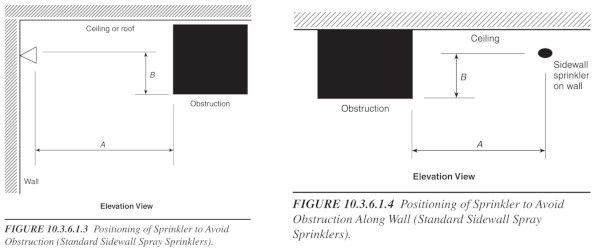
Distances between sidewall heads and obstructions on adjacent walls (NFPA 13, 2019 edition)
| TABLE 10.3.6.1.3 Positioning of Sprinklers to Avoid Obstructions (Standard Sidewall Spray Sprinklers) | |||||||||||
| Distance from Sidewall Sprinkler to Side of Obstruction (A) | Maximum Allowable Distance of Deflector Above Bottom of Obstruction (B) [in. (mm)] | ||||||||||
| 4 ft (1.2 m) to less than 5 ft (1.5 m) | 1 (25) | ||||||||||
| 5 ft (1.5 m) to less than 5 ft 6 in. (1.7 m) | 2 (50) | ||||||||||
| 5 ft 6 in. (1.7 m) to less than 6 ft (1.8 m) | 3 (75) | ||||||||||
| 6 ft (1.8 m) to less than 6 ft 6 in. (2.0 m) | 4 (100) | ||||||||||
| 6 ft 6 in. (2.0 m) to less than 7 ft (2.1 m) | 6 (150) | ||||||||||
| 7 ft (2.1 m) to less than 7 ft 6 in. (2.3 m) | 7 (175) | ||||||||||
| 7 ft 6 in. (2.3 m) to less than 8 ft (2.4 m) | 9 (225) | ||||||||||
| 8 ft (2.4 m) to less than 8 ft 6 in. (2.6 m) | 11 (275) | ||||||||||
| 8 ft 6 in. (2.6 m) or greater | 14 (350) | ||||||||||
Distances for sidewall sprinklers sharing a wall with an obstruction (NFPA 13, 2019 edition)
| TABLE 10.3.6.1.4 Positioning of Sprinklers to Avoid Obstructions Along Wall (Standard Sidewall Spray Sprinklers) | |||||||||||
| Distance from Sidewall Sprinkler to Side of Obstruction (A) | Maximum Allowable Distance of Deflector Above Bottom of Obstruction (B) [in. (mm)] | ||||||||||
| 4 in. (100 mm) to less than 6 in. (150 mm) | 1 (25) | ||||||||||
| 6 in. (150 mm) to less than 1 ft (300 mm) | 2 (50) | ||||||||||
| 1 ft (300 mm) to less than 1 ft 6 in. (450 mm) | 3 (75) | ||||||||||
| 1 ft 6 in. (450 mm) to less than 2 ft (600 mm) | 4 1/2 (115) | ||||||||||
| 2 ft (600 mm) to less than 2 ft 6 in. (750 mm) | 5 3/4 (145) | ||||||||||
| 2 ft 6 in. (750 mm) to less than 3 ft (900 mm) | 7 (175) | ||||||||||
| 3 ft (900 mm) to less than 3 ft 6 in. (1.1 m) | 8 (200) | ||||||||||
| 3 ft 6 in. (1.1 m) to less than 4 ft (1.2 m) | 9 1/4 (230) | ||||||||||
| 4 ft (1.2 m) to less than 4 ft 6 in. (1.4 m) | 10 (250) | ||||||||||
| 4 ft 6 in. (1.4 m) to less than 5 ft (1.5 m) | 11 1/2 (290) | ||||||||||
| 5 ft (1.5 m) to less than 5 ft 6 in. (1.7 m) | 12 3/4 (320) | ||||||||||
| 5 ft 6 in. (1.7 m) to less than 6 ft (1.8 m) | 14 (350) | ||||||||||
| 6 ft (1.8 m) to less than 6 ft 6 in. (2.0 m) | 15 (375) | ||||||||||
| 6 ft 6 in. (2.0 m) to less than 7 ft (2.2 m) | 16 1/4 (410) | ||||||||||
| 7 ft (2.2 m) to less than 7 ft 6 in. (2.3 m) | 17 1/2 (440) | ||||||||||
We’ve just scratched the surface of NFPA 13’s sprinkler head obstruction distance rules
This concludes part two of our look at NFPA 13’s rules regarding distances for sprinkler heads. We’ve covered the core sprinkler head obstruction distance rules for standard spray heads—and while they’re the most common type, they’re just one of several addressed by the standard. For more, check out part 1 in our series on distances for standard spray sprinklers, and stay tuned for our next entry in the series.
This article is just one small part of QRFS’s effort to help contractors, consumers, and fire safety professionals stay in compliance with standards and codes. If you’re on the hunt for new or replacement fire sprinklers, take a look at QRFS’s selection of commercial fire sprinkler heads. Our sidewall, pendent, and upright heads are available in temperatures ranging from 155 degrees to 286 degrees Fahrenheit, with a variety of finishes and cover plates to match buildings of all kinds.
Check out our selection of more than 120 commercial fire sprinklers.
Questions? Call us at +1 (888) 361-6662 or email support@qrfs.com.
This blog was originally posted at blog.qrfs.com. Check us out at Facebook.com/QuickResponseFireSupply or on Twitter @QuickResponseFS.


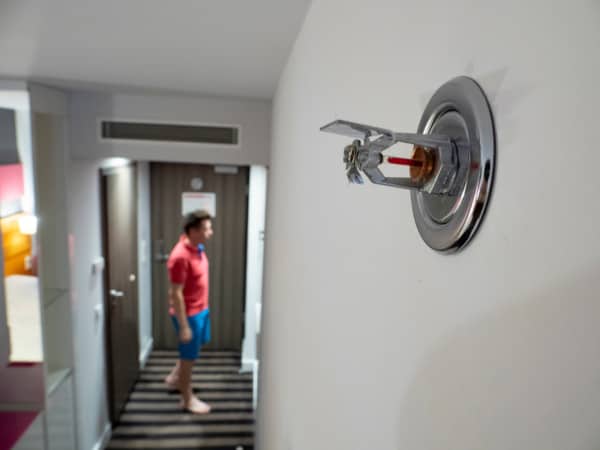

If I have a standard sprinkler head 6′ away from a wall that has metal shelves going to the ceiling, do I have to keep items 18′ down from the ceiling?
Hi Brad – the 18″ rule is designed to avoid impacting the sprinkler’s spray pattern, so it can protect the area around and underneath. Also, quick response sprinklers are designed to wet the walls so as to keep the temperature down while suppressing the fire. So its best to avoid anything that obstructs it from doing its job. That said, 6 foot seems like a safe distance but the only person who can tell you for certain is your local AHJ (like your fire marshal or fire department). Give them a call to confirm so as to avoid any issues during your annual inspection.
Hi we install flat concealed pendent model RD208 – Wondering how far away you need to be from a ceiling light ? is it 300 mm ?
Thanks
Colin, your local fire marshal or authority having jurisdiction will have the final say on sprinkler obstructions, so you should check with them to confirm you are in compliance. In general, NFPA 25: Standard for the Inspection, Testing, and Maintenance of Water-Based Fire Protection Systems says that objects that can block a sprinkler’s spray must be at least 18 inches (458 millimeters) away from the deflector.
Can i place sprinklers above perforated panels and meet code? If so how much must the panel be open? 50%, 75%?
Randy, thanks for reaching out. This is a very detailed code question that will be specific to your building location and occupancy type. We recommend using our “Ask a Pro” service, qrfs.com/ask-a-pro. Click the link to submit your question with some information about your building, and a fire protection professional will provide a written answer specific to your locality. Our pros include AHJs, contractors, engineers, and code experts with 150+ years of combined experience!
Hi,
In the 2016 NFPA 13R, Table 6.4.6.3.7.2(a) says that dimension “B” is “not allowed” if the obstruction is less than 8 feet from the sidewall head. The “B” dimension is how much the obstruction drops below the head. But what if the obstruction is only 2″ from the ceiling, and the closest a sidewall head can be to the ceiling is 4″? Then “B” is actually -2″. But that isn’t allowed?
Can someone offer a rational explanation for this, other than “it has been decreed”?
Richard, thanks for reaching out. For code questions like this, we recommend submitting your question throughQRFS Ask a Fire Pro. Click the link to submit your question with some information about your building or system, and a fire protection professional will provide a detailed answer based on standards and codes. Our pros include AHJs, contractors, engineers, and code experts with 150+ years of combined experience!
Is chain link fencing an obstruction when it goes from floor to wall ? standard spray sprinklers at the ceiling. Assuming the attachment at the ceiling above consist of a solid obstruction only 1″ deep? At what point would a full height item become an obstruction (i.e. opening percentage) ?
HS — thanks for reaching out. For system application/standards questions like this, we recommend submitting your question through QRFS Ask A Fire Pro. Click the link to submit your question with some information about your building or system, and a fire protection professional will provide a detailed answer based on standards and codes. Our pros include AHJs, contractors, engineers, and code experts with 150+ years of combined experience!
Greeting,
My question: What is the Max. distance from the floor (ground) to the sprinkler deflector?
Falah — thanks for reaching out. For system application/code questions like this, we recommend submitting your question through QRFS Ask A Fire Pro. Click the link to submit your question with some information about your building or system, and a fire protection professional will provide a detailed answer based on standards and codes. Our pros include AHJs, contractors, engineers, and code experts with 150+ years of combined experience!
How far away can a light be from a pendant head in commercial construction
Austin — The rules vary based on sprinkler spray type, the orientation and placement of the light, etc. If the info is not in this blog based on the characteristics of your sprinkler and situation, you can submit a question to our Ask a Fire Pro service. Click the link to submit your question with some information about your building or system, and a fire protection professional will provide a detailed answer based on standards and codes. Our pros include AHJs, contractors, engineers, and code experts with 150+ years of combined experience!
We have a water sprinkler head that is 5 inches from wall to the spray head. We want to put a fireplace and TV wall about 8 inches out from the wall and stay one foot from under the sprinkler head. Will that meet code? If not could we go out the 5 inches of the sprinkler head? Thanks!
Tim — thanks for reaching out. For inquiries like this, we recommend submitting your question through QRFS Ask A Fire Pro. Click the link to submit your question with some information about your building or system, and a fire protection professional will provide a detailed answer based on standards and codes. Our pros include AHJs, contractors, engineers, and code experts with 150+ years of combined experience!
On a residential home…. What is the required amount of space should a fire sprinkler pipe be from the bottom side of a slope wood deck?
Johnny — For system installation standard questions like this, you can try our Ask a Fire Pro service. Click the link to submit your question with some information about your building, and a fire protection professional will provide an answer based on best practices, standards, and codes. Our pros include AHJs, contractors, engineers, and code experts with 150+ years of combined experience!
I am remodeling my bathroom. There is a sprinkler head currently within 12 inches of both a wall and an obstruction(tall linen armoire). The proposed plan removes the armoire, knocks down the wall and installs a walk in shower with a floor to ceiling glass wall 12 inches away from the original wall. This may be a stupid question, but, is it ok to have sprinklers in showers? Would I need install a glass wall(Ie; drop the glass wall down 6 inches)
Jay — For system application questions like this, you can try our Ask a Fire Pro service. Click the link to submit your question with some information about your building, and a fire protection professional will provide an answer based on best practices, standards, and codes. Our pros include AHJs, contractors, engineers, and code experts with 150+ years of combined experience!
I have upright fire sprinklers and was wondering if I could install my duct work to pass under the sprinkler, and if so, what would the clearance have to be? The distance from the top was said to be 1″ minimum, please correct me if I am wrong. Thank You
Aram — Unfortunately, sprinkler distance rules are complex and involve multiple factors, particularly concerning uprights that are often specifically used to develop a spray pattern around obstructions. We wouldn’t be comfortable issuing a directive in this context without further information, etc. Your best course of action is to consult a fire protection professional in your area who can evaluate your specific system and its design needs. Thanks for reading!
Can anyone reference in NFPA25 where heads less than 6′ from each other is no good and creates a cold head?
Rick — We believe you are referencing ‘minimum distance between sprinklers’ rules unless they are protected by baffles (water shields) that prevent spray from cooling down the heat-sensitive element, which could delay activation. Those references are in NFPA 13, such as this one below from the 2022 edition covering pendents and uprights (similar sections also cover sidewalls). Hope that helps:
10.2.5.4 Minimum Distances Between Sprinklers.
10.2.5.4.1 Unless the requirements of 10.2.5.4.2 or 10.2.5.4.3 are met, sprinklers shall be spaced not less than 6 ft (1.8 m) on center.
10.2.5.4.2 Sprinklers shall be permitted to be placed less than 6 ft (1.8 m) on center where the following conditions are satisfied:
(1) Baffles shall be arranged to protect the actuating elements.
(2) Baffles shall be of solid and rigid material that will stay in place before and during sprinkler operation.
(3) Baffles shall be not less than 8 in. (200 mm) long and 6 in. (150 mm) high.
(4) The tops of baffles shall extend between 2 in. and 3 in. (50 mm and 75 mm) above the deflectors of upright sprinklers.
(5) The bottoms of baffles shall extend downward to a level at least even with the deflectors of pendent sprinklers.
Sorry, I’m not sure exactly what distances I need to be looking at here. I’ve got a sprinkler head on a pipe maybe 18″ down from the ceiling. We’d like to put acoustic treatment (panels or tiles, 1-3″ thick) up near the ceiling in that general area. How far, laterally and vertically, from the sprinkler head do we need to be?
Will — Unfortunately, the rules are complex and depend on the depth of the object and how close it is to the sprinklers. This blog lays out how some of those rules work with a specific case. We have an Ask a Fire Pro service where a pro can examine the situation and interpret based on information you provide and codes and standards. The page is under technical maintenance at the moment, but you can email support@qrfs.com and they can fill you in on the details if you are interested. Thanks!